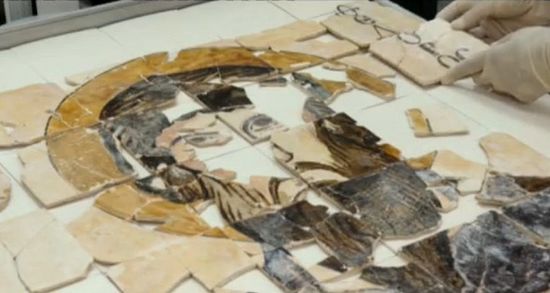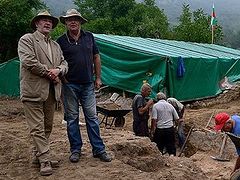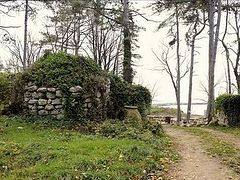Source: Archaeology in Bulgaria
October 1, 2015
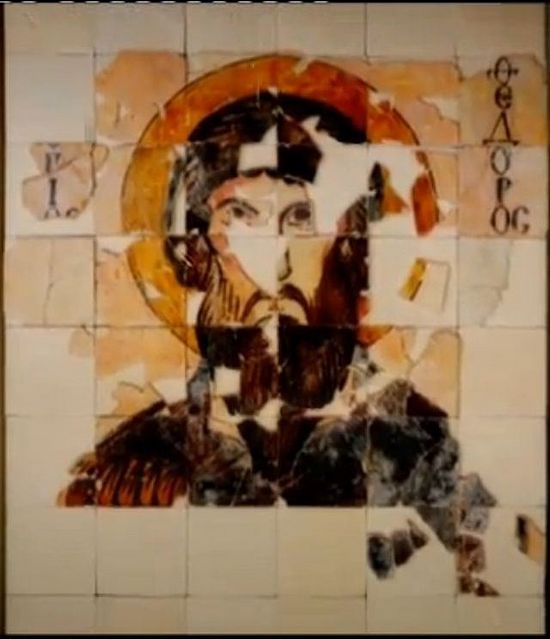 The icon of St. Theodore Stratilates, the oldest known Bulgarian-made icon (ca. 900 AD), seen here after its new restoration, with the addition of newly discovered fragments from the saint’s shoulder, beard, and face, as well as the side inscriptions. View below the icon as it was known for about 100 years (since its discovery in the early 20th century), before the adding of the newly found fragments. Photo: TV grab from BNT
The icon of St. Theodore Stratilates, the oldest known Bulgarian-made icon (ca. 900 AD), seen here after its new restoration, with the addition of newly discovered fragments from the saint’s shoulder, beard, and face, as well as the side inscriptions. View below the icon as it was known for about 100 years (since its discovery in the early 20th century), before the adding of the newly found fragments. Photo: TV grab from BNT
New fragments have been discovered from the earliest known Bulgarian-made icon – a ceramic icon of St. Theodore Stratilates dating back to the 10th century AD, the height of the First Bulgarian Empire (632/680-1018 AD) – and the icon itself has been restored for the first time since its discovery in the early 20th century.
The restored icon of St. Theodore Stratilates, which is one of Bulgaria’s national symbols, has now been shown for the first time with the added newly discovered fragments at the National Institute and Museum of Archaeology of the Bulgarian Academy of Sciences in Sofia.
The icon was found at the beginning of the 20th century during archaeological excavations of themedieval Bulgarian monastery Patleyna located 2 km south of Veliki Preslav, today a small town in Northeast Bulgaria which was the glorious capital of the First Bulgarian Empire between 893 and 970 AD, connected with the reign of Tsar Simeon I the Great (r. 893-927 AD) and the period known as the (First) Golden Age of Bulgarian literature and culture.
St. Theodore Stratilates was a 3rd century saint from Anatolia, today in Turkey; he died a martyr’s death in the ancient city of Heraclea Pontica in 319 AD as a defender of the Christian faith during the reign of Roman Emperor Licinius I (r. 308-324 AD).
(It is assumed that the Veliki Preslav icon is of St. Theodore Stratilates of Heraclea Pontica, though it is possible that it is of another saint with the same name, St. Theodore Tiron of Amasea. Another hypothesis has it that the images of the two Early Christian saints named St. Theodore might have been merged into the icon.)
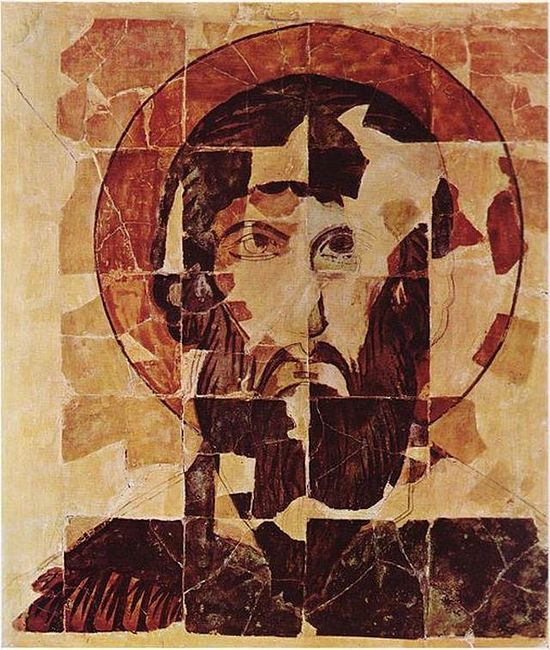 This picture shows the icon of St. Theodore Stratilates as it has been known since its discovery in the 1910s, before the latest addition of the previously unknown fragments and its latest restoration. Photo: Wikipedia
This picture shows the icon of St. Theodore Stratilates as it has been known since its discovery in the 1910s, before the latest addition of the previously unknown fragments and its latest restoration. Photo: Wikipedia
The new restoration of what is probably Bulgaria’s most famous icon, which has toured the world’smuseums for decades, is important not only because it is the first time the icon of St. Theodore Stratilates has been restored since the original restoration made at the time of its discovery, but also because the archaeologists and restorers have discovered new fragments from it in the inventory of the Veliki Preslav Museum of Archaeology.
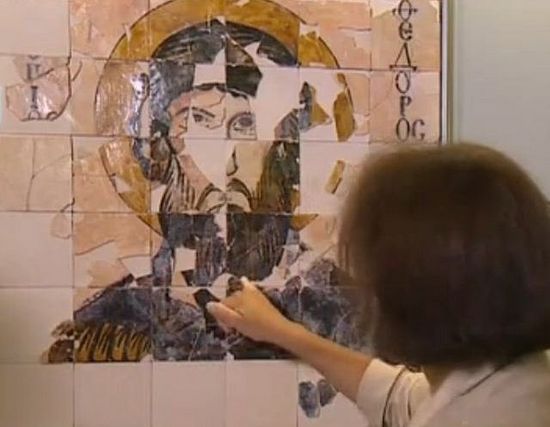 The restoration and adding of newly found fragments to the 10th century icon of St. Theodore Stratilates made of painted ceramics from Veliki Preslav, capital of the First Bulgarian Empire in 893-970 AD, during the Golden Age of Old Bulgarian culture and literature. Photos: TV grabs from BNT
The restoration and adding of newly found fragments to the 10th century icon of St. Theodore Stratilates made of painted ceramics from Veliki Preslav, capital of the First Bulgarian Empire in 893-970 AD, during the Golden Age of Old Bulgarian culture and literature. Photos: TV grabs from BNT
The new fragments have been added to the icon of the 3rd century AD martyr; they include previously unknown side inscriptions mentioning the name of the saint as “Theodore” as well as fragments from the saint’s face, beard, and body.
Thus, they indicate that the ceramic icon was probably much larger depicting the standing St.Theodore Stratilates holding a cross, rather than just his head.
The icon is a sample of a form of art known as the painted ceramics from Veliki Preslav which is seen as one of the epitomes of the so called Golden Age of Old Bulgarian culture and literature in the Old Bulgarian language (also known today as Church Slavonic) when Bulgaria’s cultural influence spread to other Slavic peoples in South and Eastern Europe.
The restoration of the icon made of painted ceramics has been necessitated by the discovery of itspreviously unknown fragments but also but the fact that its condition had worsened as a result of its exhibition in numerous museums around the world.
“[The original restoration] was done in the early 20th century by people who were discoverers. They used the materials they knew – we can’t judge them for that. That was their level of knowledge and technical capabilities,” Cherneva says, as cited by the Bulgarian National Television.
“The restoration was necessary because of the exacerbated condition of the icon. Sevdalina Neykovaand I have been working for years on the restoration of ceramics from Veliki Preslav, we are personally and professionally interested in it. We have done our best to make a contemporary restoration meeting the requirements of modern-day best practices in conservation. As far as the icon itself is concerned, it is unique in its way of decoration and image creation, and has no analogy in the entire world,”elaborates the restorer.
The decision to restore the icon of St. Theodore Stratilates was made two years ago when the experts found the cause of its worsening condition.
“The fragments were placed in plaster which is not elastic. It is fragile, and there is no otherreinforcement. This was the reason cracks appeared during the icon’s transportation,” explainsCherneva.
The restoration has not only made the earliest known Bulgarian–made icon shine with brighter colors using closer to the original techniques but it has expanded it now that new pieces of it have been found.
“There are new fragments added here around the shoulder, the beard, and the face,” shows the restorer, making it clear the icon must have been larger than previously thought.
Because of its condition, the icon of St. Theodore Stratilates made of painted ceramics from themedieval Bulgarian capital Veliki Preslav cannot be moved from the building of the National Museum of Archaeology in Sofia.
You can learn more about Bulgaria’s adoption of Christianity at the time of the First Bulgarian Empire, and about Bulgaria’s Golden Age during the reign of Tsar Simeon I the Great in the Background Infonotes below.
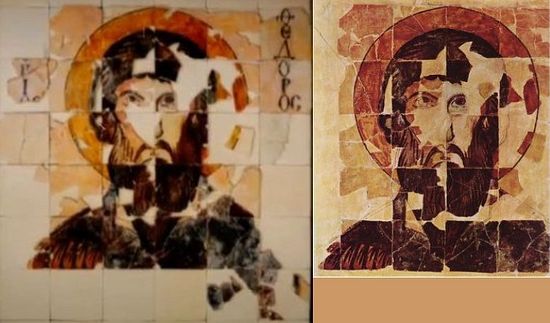 A comparison shows the difference between how Bulgaria’s 10th century icon of St. Theodore Stratilates looks before (right) and after (left) its latest restoration with the addition of the newly found fragments. Photos: BNT, Wikipedia
A comparison shows the difference between how Bulgaria’s 10th century icon of St. Theodore Stratilates looks before (right) and after (left) its latest restoration with the addition of the newly found fragments. Photos: BNT, Wikipedia
Background Infonotes:
Pliska and Veliki Preslav (Great Preslav) are two of the capitals of the First Bulgarian Empire.Pliska was the capital of the First Bulgarian Empire in 680-893 AD, and Veliki Preslav in 893-970 AD, at the height of the Bulgarian state. The state capital was moved from Pliska to Veliki Preslav, a newmedieval city nearby, in 893 AD in order to seal Bulgaria’s adoption of Christianity and the Bulgarian (Slavic, Cyrillic) script (in 865 and 886 AD, respectively). The ruins of both Pliska and Veliki Preslav can be seen today in the Shumen District in Northeast Bulgaria.
Bulgaria’s adoption of Christianity as the formal and only state religion took place in 864-865 AD under the leadership of Khan / Knyaz Boris I Mihail (r. 852-889; 893 AD).
As a result of the successful reigns of Khan (or Kanas) Krum (r. 803-814 AD), Khan (Kanas) Omurtag (r. 814-831 AD), Khan (Kanas) Malamir (r. 831-836), and Khan (Kanas) Presian (r. 836-852 AD), by the middle of the 9th century the First Bulgarian Empire had become a huge empire spanning from theBlack Sea in the east to the Adriatic Sea in the west, and from the Northern Carpathian Mountains in the north to the Aegean Sea in the south, including the entire or part of the territory of modern-dayBulgaria, Romania, Serbia, Greece, Turkey, Albania, Macedonia, Hungary, Moldova, and Ukraine.However, the major peoples inhabiting the Bulgarian Empire – the Ancient Bulgars (whose religion is known as tengriism) and the Slavs as well as the local Thracian population and others – worshipped different gods according to their own religions and mythologies. This was true even though there were entire areas in the then Bulgarian Empire which had been Christianized in earlier periods, and even though the first Khans from the House of Dulo are believed to have been Christians who werebaptized by the imperial court of the Eastern Roman Empire, i.e. Byzantium: Khan (Kanas) Kubrat (r. ca. 630-ca.660) who founded the so called Old Great Bulgaria in 632 AD on the territory of much ofmodern-day Ukraine and Southwest Russia; Khan (Kanas) Asparuh (r. ca. 680-700) who expanded the state to the southwest technically creating modern-day Danube Bulgaria around 680 AD; and Khan (Kanas) Tervel (r. 700-718/721) who saved Europe from an Arab invasion during the siege of Constantinople in 717 AD. This led Khan Boris I to decide to unite the different ethnicities in the First Bulgarian Empire with a new common religion, and to pick Christianity (even though the adoption of Islam and Judaism were also offered to him by foreign emissaries) because Bulgaria was then the only still pagan major European power, and he wanted Bulgaria to be treated as an equal by the Byzantine Empire in the east and the successors of the Frankish Empire in the west.
While Khan Boris I initially intended to adopt the Western form of Christianity from the Pope in Romevia the Kingdom of the East Franks (East Francia in modern-day Germany) because Byzantium had been Bulgaria’s major geopolitical foe, he was forced to change his decision after an unsuccessful war with the Byzantines imposed on him the adoption of the Eastern form of Christianity as part of apeace treaty signed in 863 AD. This resulted after the First Bulgarian Empire had had to fight simultaneously Byzantium in the southeast and Great Moravia in the northwest. Thus, in 863 or 864 AD, a mission from the Patriarch of Constantinople Photios came to Pliska and converted theBulgarian Tsar, his family and high-ranking dignitaries, who were baptized as Christians. Khan Boris I became Knyaz Boris I Mihael – taking the name of his baptist, Byzantine Emperor Michael III (r. 842-867 AD), and in 865 AD there was baptism en masse of the entire Bulgarian population. Thus, even though the subsequent years saw the first major clashes between the Pope in Rome and the Ecumenical Patriarch in Constantinople over the “Bulgarian Question”, i.e. whose diocese the large and powerful newly baptized First Bulgarian Empire should belong to, Bulgaria remained in the camp of Eastern Orthodox Christianity subsequently helping pass it on to later emerging nations such asSerbia and Russia, and thus modifying forever the history of Europe.
Bulgaria’s adoption of Christianity, however, went far from smoothly, and not only because of theclashes between the Pope in Rome and the Ecumenical Patriarch in Constantinople over whose diocese the newly converted Bulgarians should belong to. In 865, conservative Bulgar aristocrats from all 10komitats (administrative regions) of the First Bulgarian Empire revolted against Boris, who now took the Christianized title of Knyaz (i.e. King) in order to restore the old religion, tengriism. Knyaz Boris Imanaged to suppress the revolt executing 52 Bulgarian boyars (heads of noble families). According to some sources, he also had their entire extended families executed. Until the end of his life, Knyaz Boris was haunted by guilt about the harshness of his measures and the moral price of his decision in 865. In his later correspondence with Pope Nicholas I, the Knyaz asked whether his actions had crossed the borders of Christian humility, for which the Pope offered forgiveness: “You have sinned rather because of zeal and lack of knowledge, than because of other vice. You receive forgiveness and grace and the benevolence of Christ, since penance has followed on your behalf.”
Knyaz Boris realized that the Christianization of Bulgaria gave Byzantium great influence over the domestic affairs of the Bulgarian Empire. Thus, juggling the differences of Rome and Constantinople,he eventually managed to get Byzantium’s Ecumenical Patriarchate as well as the Pope in Rome to recognize an independent (autocephalous) Bulgarian Archbishopric, which was created in 870 AD in an unprecedented development for Europe because independent churches had been only those founded by Apostles or Apostles’ disciples. For example, the Papacy in Rome had been challenging Constantinople’s claim of equality to Rome on the grounds that the Church of Constantinople had not been founded by an Apostle of Jesus Christ. Nonetheless, this development was also a success forByzantium, and during the decade after 870 AD, Pope Adrian II and his successors kept trying desperately to convince Bulgaria’s Knyaz Boris to leave Constantinople’s religious sphere.
Knyaz Boris I Mihail sealed the success of his deed, the adoption of Christianity, in 886 AD whenBulgaria welcomed the disciples of St. Cyril and St. Methodius, St. Kliment Ohridski and St. Naum Preslavski, helping them to teach thousands of Bulgarian clergymen to serve in Bulgarian. Thus,Bulgaria adopted the Bulgarian script, also known as the Slavic script – first the Glagolithic and then the Bulgarian (Cyrillic) alphabet. This allowed Knyaz Boris, and his successor Tsar Simeon I the Greatto declare Bulgarian (also known as Old Bulgarian or Church Slavonic) as the official language of the Bulgarian Orthodox Church during the Council of Preslav in 893 AD (which also moved Bulgaria’s capital from Pliska to Veliki Preslav (Great Preslav)). As all over Europe religious services were held in the “official” church languages Latin and Greek, this “nationalization” of the liturgy language byBulgaria became another exceptional development in medieval Europe after the recognition of the independent Bulgarian church.
Tsar Simeon I the Great was the ruler of the First Bulgarian Empire (632/680-1018 AD) in 893-927 AD. He was probably the most powerful Bulgarian leader of all time in his capacity as both a military commander and a patron of spiritual life, culture, and literature. During his reign Bulgaria probably saw its greatest territorial expansion (although some scholars argue that its territory was slightly greater during the reign of Tsar Samuil (r. 977/997-1014 AD)) coving all of Southeast Europe and much of Central Europe (estimates range around 650,000 sq. km.), including all or parts of modern-day Bulgaria, Romania, Greece, Turkey, Serbia, Albania, the Republic of Macedonia, Kosovo, Montenegro, Bosnia, Hungary, Moldova, and Ukraine, bordering on the three seas – the Black Sea, the Aegean, and the Adriatic. What is deemed more important, however, is that his reign saw the so called Golden Age of Old Bulgarian culture and literature in the Old Bulgarian language (also known today as Church Slavonic), with its cultural influence later spreading to other Slavic peoples in South and Eastern Europe.
The future Tsar Simeon was born in 864 or 865 AD, at about the time the First Bulgarian Empire adopt Christianity as its official and only religion. He was the third son of St. Knyaz Boris I (r. 852-889; 893 AD), and since he was intended to become head of the Bulgarian Orthodox Church, his father sent him to be educated at the Imperial University of Constantinople, the capital of the Byzantine Empire, also known as the University of the Palace Hall of Magnaura. Simeon studied there between ca. 878 and ca. 888 AD, and because of his erudition, Byzantine chroniclers to refer to him later as “the half-Greek”. After his return to Bulgaria, Simeon started participating in the translation of religious works fromGreek into Bulgarian at the Preslav Literary School. However, Knyaz Vladimir Rasate (r. 889-893 AD), Knyaz Boris I’s first-born son and successor to the throne, attempted to abandon the recently introduce Christianity and restore paganism. This led the aged Knyaz Boris to lead a de facto coup d’etat removing Vladimir from the throne, and making Simeon the Knyaz (King) of Bulgaria during the Preslav Council (Assembly) of 893 AD which also decided to move the capital of the First Bulgarian Empire from Pliska to Veliki Preslav (Great Preslav) in order to do away with any pagan traditions.
The young Knyaz Simeon’s reign did not begin smoothly but with what has been described as the first commercial war in medieval Europe in 894 AD, after Byzantine Emperor Leo VI the Wise moved the marketplace of Bulgarian merchants from the Byzantine capital Constantinople to the city of Thessaloniki. In the ensuing military actions, Bulgaria’s forces defeated the Byzantine troops that met them, which was made easier by the fact that the main units of Byzantium were fighting the Arabs in Asia Minor. The notorious Byzantine diplomacy, however, was able to instigate a “backstabbing”attack on Bulgaria from the north by the Magyars who were ferried by the Byzantine Navy across theDanube near the river’s delta. After initial losses and withstanding a siege in the strong Bulgarian fortress of Drastar (today’s Silistra known as Durostorum in Roman times) on the Danube, together with his allies the Pechenegs, the Bulgarian ruler routed the Magyars in the extremely fierce Battle of Southern Buh (in today’s Ukraine) in 895 AD which eventually led their tribes to retreat to the west and settle in the region of Pannonia essentially founding today’s Hungary.
What followed was a constant military conflict between Bulgaria and Byzantium. The Byzantine army was defeated by the Bulgarian forces in the Battle of Bulgarophygon (today’s Babaeski in Turkey) in 896 AD, who then besieged Constantinople. The war ended with a peace treaty after the Byzantine Empire sued for peace and agreed to pay annual tribute to Bulgaria, and ceded parts of the region ofThrace. After the Arabs plundered the city of Thessaloniki, in 904 AD, Leo VI ceded all Slav-populated territories in today’s Northern Greece, the Republic of Macedonia, and Albania in order to dissuadeSimeon from capturing Thessaloniki and populating it with Slavs, as the Bulgarian ruler intended. In the meantime, Knyaz Simeon included Serbia as a vassal in the First Bulgarian Empire. The peacegenerally held until 912 AD when Byzantine Emperor Leo VI the Wise died which led to a successioncrisis and strife for the Byzantine throne. After a Byzantine regent refuse to pay the annual tribute to Bulgaria, the troops of the First Bulgarian Empire besieged Constantinople again in 913 AD. In the ensuing negotiations, the Byzantine tribute was paid, and Simeon was promised that the minor Emperor Constantine VII would marry one of his daughters technically allowing him to lay a claim to the throne in Constantinople. The following year, however, the deal was broken by Empress Zoe,Emperor Constantine’s mother, leading to a resumption of the Bulgarian-Byzantine war in whichSimeon’s forces captured the city of Adrianople (today’s Edirne in Turkey).
A major clash of the two empires occurred in the summer of 917 AD, when the Byzantines first tried to organize a wide-ranging international coalition against the Bulgarian Empire, and marched againstBulgaria with a huge army of their own led by Byzantine general Leo Phocas (Phokas) the Elder, and a fleet led by Romanus Lecapenus (Romanos Lekapenos), later Byzantine Emperor (r. 920-944 AD). On August 20, 917 AD, in the Battle of Anchialos, also known as the Battle of the Achelous (Acheloos) Rivernear the Black Sea coast, which was one of the largest battles in medieval history, the Bulgarian forces annihilated almost the entire Byzantine army in which only about 2,000 of the total of some 62,000 troops survived. The Bulgarian Emperor personally led a cavalry charge, and his white horse was killed at the height of the battle. Byzantine chronicler Leo the Deacon, who visited the site of the Battle of Anchialos 75 years later, wrote that “piles of bones can still be seen today at the river Acheloos, where the fleeing army of the Byzantines was then infamously slain”. The Byzantine defeat at theBattle of the Achelous (Acheloos) River was followed by another Bulgarian military victory in theBattle of Katasyrtai. After his great victory at Anchialos, Knyaz Simeon assumed the title of Tsar, theSlavic-Bulgarian form of Caesar, i.e. Emperor, and more specifically the titles “Basileus of All Bulgarians and Greeks” (“Basileus” being the title of the Byzantine Emperors) and “Autocrat of All Bulgarians and Romans” (referring to the fact that the Byzantine Empire was technically a continuation of the Roman Empire), and began to strive ever more stubbornly to sit on the throne in Constantinople; the head of the Bulgarian Orthodox Church was promoted from Archbishop toPatriarch. The imperial title of the Bulgarian Tsar and the Patriarchate status of the Bulgarian Church, however, were only formally recognized by Byzantium after Tsar Simeon’s death, in 927 AD, to his heir, St. Tsar Petar I (r. 927-969 AD).
In the last decade of his reign, Tsar Simeon waged even more wars in pursuit of his dream of sitting on the Byzantine throne, which, however, moved further away after in 920 AD Byzantine admiral Romanus Lecapenus (Romanos Lekapenos) removed Empress Zoe as a regent, betrothed his daughterHelene Lekapene to the underage Emperor Constantine VII, and became a Co-Emperor, which is whatBulgaria’s Tsar Simeon had aspired to do. Tsar Simeon waged wars on Byzantium even more fiercely,besieged Constantinople a couple of more times, launched a campaign down south all the way to theIsthmus of Corinth, crushed Serbian revolts and annexed all of Serbia, and even planned a joint attack on Constantinople together with Fatimid Caliph of Egypt, Ubayd Allah al-Mahdi Billah, who was supposed to contribute the Egyptian Navy; the plan failed only because the Byzantines managed to capture the Bulgarian and Egyptian envoys on their way back from Egypt. Of all his victorious wars,Tsar Simeon’s last one – against Croatia in 926 AD – was unsuccessful. He died of a heart failure in hisimperial palace in Veliki Preslav on May 27, 927 AD. Byzantine chronicles attribute his death to a magic caused by Byzantine Emperor’s Romanus Lecapenus decapitation of a statue of Simeon held in Constantinople.
While Tsar Simoen’s great territorial expansion and numerous wars, albeit victorious, are a controversial heritage because they are known to have exhausted the resources and the population of the Bulgarian Empire, his undisputedly most important heritage is the so called Golden Age – the thriving and unique Old Bulgarian culture and literature with the use of the Bulgarian (Cyrillic) alphabet which established Bulgaria as the spiritual center of the Slavic peoples. It first started underSimeon’s father, St. Knyaz Boris I Mihail in 886 AD with the arrival of two of the main disciples of St. Cyril and St. Methodius – St. Kliment Ohridskis (Clement of Ohrid) and St. Naum Preslavski (Naum of Preslav) – and the foundation of the Orhid Literary School and the Preslav Literary School. It was in this period that the first Slavic-Bulgarian alphabet, the Glagolitic, was transformed into the secondBulgarian alphabet used today by some 300 million people in Europe and Asia, which is also known international as the Cyrillic.
Under Tsar Simeon’s patronage, the Old Bulgarian medieval scholars were very active in translating Christian texts into Old Bulgarian, essentially the Slavic proto-language, including the Bible, and the works of John Chrysostom, Basil of Caesarea, Cyril of Alexandria, Gregory of Nazianzus, Athanasius of Alexandria, and the historical chronicles of John Malalas and George Hamartolus. They also authored a number of original texts in Old Bulgarian, including Yoan Ekzarh’s (John Exarch) Six Days(Shestodnev), Konstantin Preslavski’s (Constantine of Preslav) Alphabetical Prayer andProclamation of the Holy Gospels, and On Account of Letters by Chernorizets Hrabar (“The Brave Monk”, which might have been a pseudonym for Tsar Simeon himself). Tsar Simeon’s capital Veliki Preslav was built up to rival “the Second Rome”, Constantinople, with an impressive imperial palace,and dozens of churches and monasteries, including the so called Round or Golden Church, which is expected to be restored in present-day Bulgaria as a cultural tourism site. Because of these achievements, Tsar Simeon was named “the Great” by later Bulgarian historians. In the words of French historian Alfred Nicolas Rambaud (1842-1905), “Simeon was the Bulgarian Charlemagne, but he was better educated than our Charles the Great and much greater than him, for he laid down the foundations of literature that belonged to the people.”

